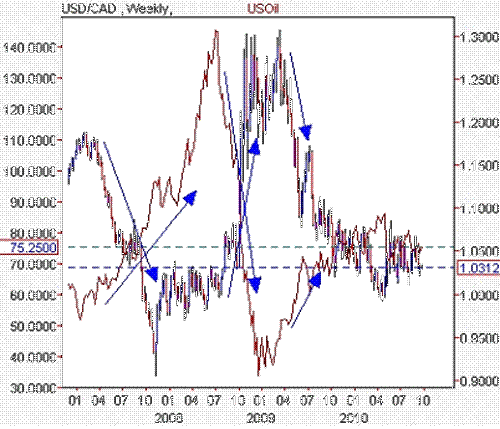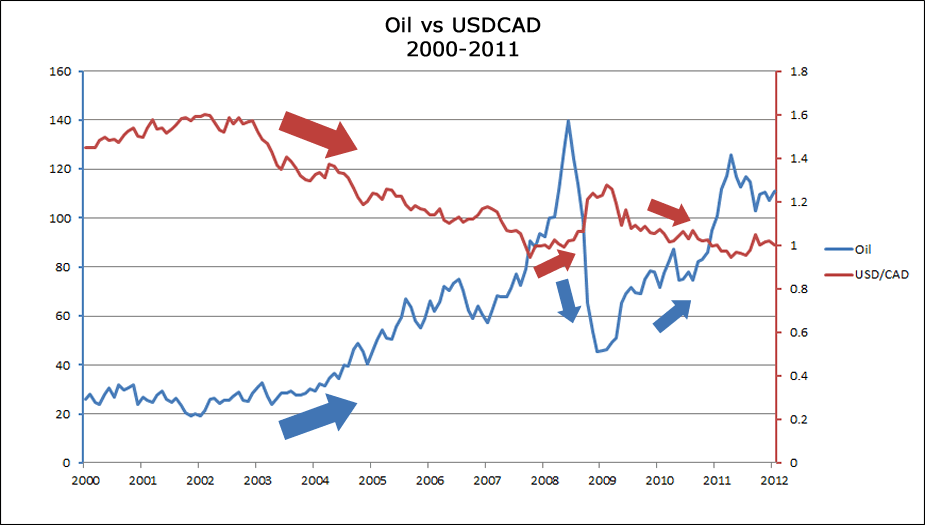Trade Oil with Currency Correlations
Post on: 19 Май, 2015 No Comment

Talking Points:
- Correlations are useful to find direction for a variety of markets. Oil and the USDCAD have a negative correlation. Once direction is found, plan your trading strategy for another asset.
Understanding market correlations can allow traders to have an option on a commodity based off of the direction of their favorite currency pair. The idea is to take two seemingly different markets or assets and see how market price moves relative to each other. Today we will review using the USDCAD currency pair to determine the direction of USOIL (WTI) through the use of a correlation.
Lets get started!
Oils Correlation
When someone mentions Oil, currency traders should immediately think of the USDCAD as a correlating currency pair. These assets are negatively correlated meaning they generally can be seen moving in opposing directions. This occurs because the USDCAD quotes the price of Canadian Dollars in terms of USDollars. USOil represents Oil per barrel priced in terms of US Dollars. With the USD being on opposing sides of each equation this means that the two assets will move in opposing directions when the USD strengthens or weakens.
Secondly, the CAD has a high correlation to Oil due to Canadas extensive oil deposits. Most of this oil is purchased by the US causing a transfer of funds along the way. As oil prices fluctuate, this increases or decreases the amount of funds transferred from USD to make purchases of Canadian resourses. These transfers essentially change demand for the currency and can directly cause changes in the USDCAD currency pair as well.
Learn Forex AUD/USD & Gold (XAU/USD ) Correlation
(Created using FXCMs Marketscope 2.0 charts)
Trading the Correlation
The key to trading negatively correlated assets is finding a direction or having a fundamental opinion from one of the underlying assets before making a trading decision. If traders are seeing the USDCAD push to higher highs, this could easily be the catalyst for a bearish bias on Oil. Conversely if Oil is trending upwards traders would have reasonable expectations of the USDCAD traveling towards lower lows.
As you can see, this information is very useful to traders that already have an opinion on either Oil or the USDCAD currency pair. Often traders that are bullish on Oil choose to trade the USDCAD instead of the metal itself. The Canadian Dollar carries a 1.00% banking rate. meaning traders can earn additional interest while trading a bullish bias on Oil. If a trader is bullish on the USDCAD currency pair, traders can in turn sell Oil to avoid accumulating interest on their trading balance.

Now that you are more familiar with correlations, try trading Oil and the USDCAD using a FREE Forex demo account. This will give you an idea of how price fluctuations affect commodities and currencies while practicing your trading in real time!
—Written by Walker England, Trading Instructor
To contact Walker, email WEngland@FXCM.com. Follow me on Twitter at @WEnglandFX.
To be added to Walkers e-mail distribution list, send an email with the subject line Distribution List to WEngland@FXCM.com.
New to the FX market? Save hours in figuring out what FOREX trading is all about. Take this free 20 minute New to FX course presented by DailyFX Education. In the course, you will learn about the basics of a FOREX transaction, what leverage is, and how to determine an appropriate amount of leverage for your trading.
Register HERE to start your FOREX learning now!
DailyFX provides forex news and technical analysis on the trends that influence the global currency markets.
Learn forex trading with a free practice account and trading charts from FXCM.














